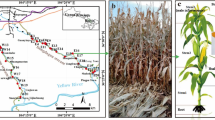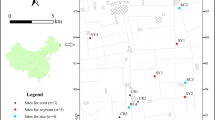Abstract
Sewage sludge has been used as a fertilizer in agriculture, but human exposure to toxins due to crop exposure has been reported. This study evaluated the uptake of essential and nonessential elements from soil (exposed to sewage sludge) to roots, shoots, and grains of corn, aiming to estimate the daily intake corn consumption to assess the associated health risk. Corn plants were grown in soil amended with 0, 5, 10, and 20 tons of sewage sludge per hectare (t/ha). Soil, root, shoot, and grain samples were analyzed by inductively coupled plasma mass spectrometry. In soil, sludge application at 10 and 20 t/ha enhanced the Zn, Cu, Mo, Cd, Pb, Hg, and Ni concentration compared to control soil. Normally, corn plants exhibited essential and nonessential element concentrations significantly higher in roots than in grains and shoots. Selenium was equally distributed in roots, shoots, and grains but Mo was preferentially stored in grains. Cadmium, As, and Pb were more efficiently trapped in roots than other elements. Considering the estimated daily intake, for Brazilians, the concentrations were below the toxicological or the dietary reference values. In conclusion, chemical elements were efficiently trapped in roots and therefore applying 5 t/ha proportion of sewage sludge might be a sustainable and cost-effective strategy, with a very lower risk of toxicity due to consumption of grains. In contrast, sewage sludge at 20 t/ha enhanced element levels in plant parts and in places with higher corn consumption, estimated daily intakes are expected to rise.


Similar content being viewed by others
References
Abbas, M. H. H., & Meharg, A. A. (2008). Arsenate, arsenite and dimethyl arsenic acid (DMA) uptake and tolerance in corn (Zea mays L.). Plant and Soil, 304, 277–289.
ATSDR—Agency for Toxic Substances and Disease Registry. (2005). Toxicological profile for nickel.
Baig, J. A., Kazi, T. G., Shah, A. Q., et al. (2010). Evaluating the accumulation of arsenic in corn (Zea mays L.) plants from its growing media by cloud point extraction. Food and Chemical Toxicology, 48, 3051–3057.
Batista, B. L., Nigar, M., Mestrot, A., et al. (2014). Identification and quantification of phytochelatins in roots of rice to long-term exposure: evidence of individual role on arsenic accumulation and translocation. Journal of Experimental Botany, 65, 1467–1479.
Bhogal, N. S., et al. (1993). Micronutrient status in AquicUstifluvents and Udifluvents as related to certain soil properties. Journal of the Indian Society of Soil Science, 41, 75–78.
Bose, S., & Bhattacharyya, A. K. (2008). Heavy metal accumulation in wheat plant grown in soil amended with industrial sludge. Chemosphere, 70, 1264–1272.
Carbonell, A. A., et al. (1998). Arsenic in wetland vegetation: availability, phytotoxicity, uptake and effects on plant growth and nutrition. Science of the Total Environment, 217, 189–199.
Chen, H., Wang, Q., Jiang, Y., Wang, C., Yin, P., Liu, X., & Lu, C. (2014). Monitoring and risk assessment of 74 pesticide residues in Pu-erh tea produced in Yunnan, China. Food Additives and Contaminants: Part B Surveillance, 8, 1–7.
Clarke, B. O., & Smith, S. R. (2011). Review of ‘emerging’ organic contaminants in biosolids and assessment of international research priorities for the agricultural use of biosolids. Environment International, 37(1), 226–247.
Clemens, S. (2006). Toxic metal accumulation, responses to exposure and mechanisms of tolerance in plants. Biochimie, 88, 1707–1719.
CONAMA—Conselho Nacional do Meio Ambiente. (2006). Environmental National Council. Brazil: Resolution number 375.
EC—European Commission. Environmental, economic and social impacts of the use of sewage sludge on land (2010). Consultation report on options and impacts. Milieu Ltd. WRc and RPA, Belgium. http://www.sede-environnement.com/sede-water/ressources/documents/1/15980,1-Draft-Impact-Assessment-Sludge-D.pdf. Accessed 15 July 2014.
EFSA—European Food Safety Authority. EFSA Panel on Contaminants in the Food Chain (CONTAM). Scientific opinion on arsenic in food (2009). EFSA Journal, 7(10), 1351 (199 p.), doi:10.2903/j.efsa.2009.1351.
EFSA—European Food Safety Authority. EFSA Panel on Contaminants in the Food Chain (CONTAM). Scientific opinion on lead in food (2010). EFSA Journal, 8(4), 1570 (p.147).
Environmental Agency. (2009). Contaminants in soil: updated collation of toxicological data and intake values for humans. Nickel.
EPA (2000). United States Environmental Protection Agency. Nickel compounds. Hazard summary—created in April 1992; Revised in January 2000. Available from http://www.epa.gov/ttnatw01/hlthef/nickel.html. Accessed 27 November 2014.
FAO/WHO. (2010). Joint FAO/WHO Expert Committee on Food Additives (JECFA). Geneva: 73th meeting Geneva.
Frąc, M., Oszust, K., Lipiec, J., Jezierska-Tys, S., & Nwaichi, E. O. (2014). Soil microbial functional and fungal diversity as influenced by municipal sewage sludge accumulation. International Journal of Environmental Research and Public Health, 11(9), 8891–8908. doi:10.3390/ijerph110908891.
Grotto, D., Carneiro, M. F. H., Sauer, E., Garcia, S. C., De Melo, W. J., & Barbosa, F., Jr. (2013). Evaluation of biochemical and redox parameters in rats fed with corn grown in soil amended with urban sewage sludge. Ecotoxicology and Environmental Safety, 95, 188–194.
IITA—International Institute of Tropical Agriculture Available (2014). Available in http://www.iita.org/maize. Accessed 18 December 2014.
IOM—Institute of Medicine. (2002). Dietary reference intakes for vitamin A, vitamin K, arsenic, boron, chromium, copper, iodine, manganese, molybdenum, nickel, silicon, vanadium and zinc. Institute of Medicine, Washington (DC, USA): National Academy Press.
Jarausch-Wehrheim, B., Mocquot, B., & Mench, M. (1999). Absorption and translocation of sludge-borne zinc in field-grown maize (Zea mays L.). European Journal of Agronomy, 11(1), 23–33.
Kidd, P. S., Domínguez-Rodríguez, M. J., & Monterroso, C. (2007). Bioavailability and plant accumulation of heavy metals and phosphorus in agricultural soils amended by long-term application of sewage sludge. Chemosphere, 66, 1458–1467.
Kim, I. S., Kang, K. H., Johnson-Green, P., & Lee, E. J. (2003). Investigation of heavy metal accumulation in Polygonum thunbergii for phytoextraction. Environmental Pollution, 126, 235–243.
Liu, A., Hamel, C., Hamilton, R. I., Ma, B. L., & Smith, D. L. (2000). Acquisition of Cu, Zn, Mn and Fe by mycorrhizal corn (Zea mays L.) grown in soil at different P and micronutrient levels. Mycorrhiza, 9, 331–336.
Mantovi, P., Baldoni, G., & Toderi, G. (2005). Reuse of liquid, dewatered, and composted sewage sludge on agricultural land: effects of long-term application on soil and crop. Water Research, 39, 289–296.
Meng, X. Z., et al. (2014). Flow of sewage sludge-borne phthalate esters (PAEs) from human release to human intake: implication for risk assessment of sludge applied to soil. Science of the Total Environment, 476–7, 242–249.
ABIMILHO—Associação Brasileira das Indústrias do Milho (2012) (in Portuguese). Resource Document. http://www.abimilho.com.br/noticias/29 Accessed 15 July 2014.
Muchuweti, M., Birkett, J. W., Chinyanga, E., et al. (2006). Heavy metal content of vegetables irrigated with mixture of wastewater and sewage sludge in Zimbabwe: implications for human health. Agriculture, Ecosystems & Environment, 112, 41–48.
Nkoa, R. (2014). Agricultural benefits and environmental risks of soil fertilization with anaerobic digestates: a review. Agronomy for Sustainable Development, 34(2), 473–492.
Nogueirol, R. C., De Melo, W. J., Bertoncini, E. I., & Alleoni, L. R. F. (2013). Concentrations of Cu, Fe, Mn, and Zn in tropical soils amended with sewage sludge and composted sewage sludge. Environmental Monitoring and Assessment, 185, 2929–2938.
Ntzala, G., Koukoulakis, P. H., Papadopoulos, A. H., Leotsinidis, M., Sazakli, E., & Kalavrouziotis, I. K. (2013). Interrelationships of pollution load index, transfer factor, and concentration factor under the effect of sludge. Environmental Monitoring and Assessment, 185(6), 5231–5242. doi:10.1007/s10661-012-2939-8.
Pathak, C., Chopra, A. K., & Srivastava, S. (2013). Accumulation of heavy metals in Spinacia oleracea irrigated with paper mill effluent and sewage. Environmental Monitoring and Assessment, 185(9), 7343–7352. doi:10.1007/s10661-013-3104-8.
Raab, A., Schat, H., Meharg, A. A., & Feldmann, J. (2005). Uptake, translocation and transformation of arsenate and arsenite in sunflower (Helianthus annuus): formation of arsenic–phytochelatin complexes during exposure to high arsenic concentrations. New Phytologist, 168, 551–558.
Ranum, P., Peña-Rosas, J. P., & Garcia-Casal, M. N. (2014). Global maize production, utilization, and consumption. Annals of the New York Academy of Sciences, 1312, 105–112.
Schneider, I., Oehlmann, J., & Oetken, M. (2015). Impact of an estrogenic sewage treatment plant effluent on life-history traits of the freshwater amphipod Gammarus pulex. Journal of Environmental Science and Health, Part A: Toxic/Hazardous Substances & Environmental Engineering, 50(3), 272–281. doi:10.1080/10934529.2015.981114.
Selma, M. V., Martinez-Sanchez, A., Allende, A., Ros, M., Hernandez, M. T., & Gil, M. I. (2010). Impact of organic soil amendments on phytochemicals and microbial quality of rocket leaves (Eruca sativa). Journal of Agricultural and Food Chemistry, 58, 8331–8337.
Shenker, M., Fan, T. W. M., & Crowley, D. E. (2001). Phytosiderophores influence on cadmium mobilization and uptake by wheat and barley plants. Journal of Environmental Quality, 30, 2091–2098.
USEPA—United States Environmental Protection Agency. (1986). Test method for evaluating solid wastes. Washington: Report number SW-846.
Vieira, R. F., Moriconi, W., & Pazianotto, R. A. (2014). Residual and cumulative effects of soil application of sewage sludge on corn productivity. Environmental Science and Pollution Research International, 21(10), 6472–6481. doi:10.1007/s11356-014-2492-9.
Wagner, G. J. (1993). Accumulation of cadmium in crop plants and its consequences to human health. Advances in Agronomy, 51, 173–212.
UK Water. (2010). Recycling of biosolids to agricultural land. London, SW1H 9BT: Water UK.
Zoffoli, H. J., Do Amaral-Sobrinho, N. M., Zonta, E., Luisi, M. V., Marcon, G., & Tolón-Becerra, A. (2013). Inputs of heavy metals due to agrochemical use in tobacco fields in Brazil’s Southern Region. Environmental Monitoring and Assessment, 185(3), 2423–2437. doi:10.1007/s10661-012-2721-y.
Acknowledgments
This work was supported by the São Paulo State Foundation for Scientific Research (FAPESP, No. 2011/00842-6). The excellent technical assistance of Vanessa C. de Oliveira Souza during the experiments is gratefully appreciated.
Author information
Authors and Affiliations
Corresponding author
Rights and permissions
About this article
Cite this article
Grotto, D., Batista, B.L., Souza, J.M.O. et al. Essential and Nonessential Element Translocation in Corn Cultivated Under Sewage Sludge Application and Associated Health Risk. Water Air Soil Pollut 226, 261 (2015). https://doi.org/10.1007/s11270-015-2527-y
Received:
Accepted:
Published:
DOI: https://doi.org/10.1007/s11270-015-2527-y




